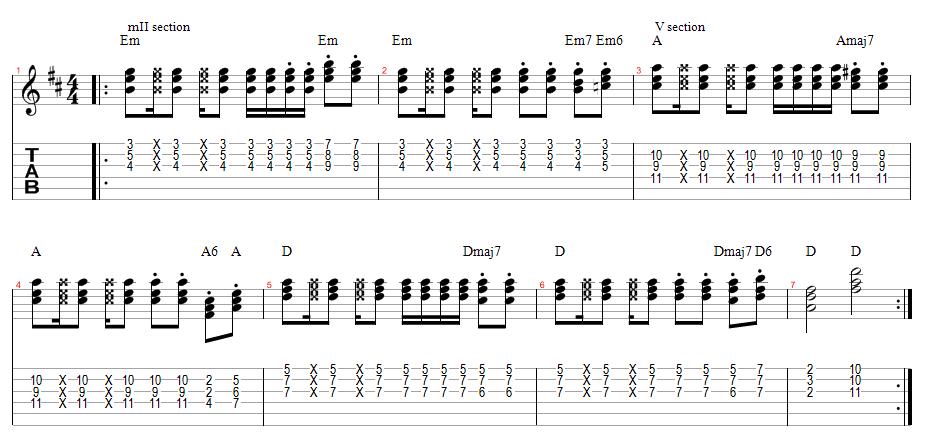Velvet Roger - Triad Replacements SI Lesson
Triad replacements
Contents |
Introduction
Hey guys, this is my 2nd S.I. video lesson. My name is Roger, am 33 years old and living in Amsterdam, The Netherlands. I've been playing the guitar seriously for about 1.5 years now (with also some less serious playing back when I was 16-17). Besides playing the guitar, I have always been involved in playing music (piano, keyboards, drums), which certainly is helpful for rhythmic feeling etc. About 5 months ago I started my own band together with two other persons, which gives a nice boost in my playing abilities as well.
I hope you will like my 2nd S.I. video lesson.
Structure
1. About the lesson
2. Theory background
3. The lesson
4. How to implement the exercises
5. Last words
1. About the lesson
This lesson is primarily aimed towards beginning/intermediate players who would like to practically use basic triads shapes to spice up their rhythm playing. Aspects covered it this lesson include:
- Basic chords, and how to use them in more advanced chords
- Fretboard interval knowledge (focussed on chords)
- Finding chords on several places on the fretboard
- Chord inversions
- Strumming patterns (not main goal of this lesson)
2. Theory background
In my previous S.I. lesson I have extensively covered the basic triad chord shapes, which are based on the C-shape, A-shape and E-shape of the so-called CAGED system.
For your reference:
My SI lesson on basic triads
Theory series by Andrew on triads
Theory explanation on CAGED by Andrew
In the current lesson, we are actually going to use exactly the same shapes, positions and inversions as in my previous SI lesson (so nothing new there ). However, we are going to delve a bit more into possible chord replacements using these already learned shapes which would spice up your rhythm playing abilities. In order to understand how we are going to replace the major and minor triads, we are going to harmonize both the major and natural minor scales.
Major Scale
First of all, I would like to refer to this excellent lesson by Andrew on how to harmonize the major scale, but in short you find below the explanations you need to understand this SI lesson:
During this SI lesson I will use D major as example. If we harmonize the D major scale this will result in the following chords (I will only show the triad-basis here):
There are two common ways to replace basic triads with, which you should remember:
- replacing the I degree chord (tonal root chord) with the III degree chord. The resulting replacement chord will actually be a major 7th chord.
- replacing the I degree chord (tonal root chord) with the VI degree chord. The resulting replacement chord will actually be a 6th chord.
So, if we look now into the building blocks of the basic triads from the harmonized D major scale, they consist of the following:
D (I chord) = D, F#, A
F#m (III chord) = F#, A, C#
Bm (VI chord) = B, D, F#
Looking at the notes from the F#m and Bm chords, you can actually also see these triads also as more complex D chords, namely:
F#m triad = DMaj7 chord = (D), F#, A, C# (however, in this case the root note is not played – shown in brackets!).
Bm triad = D6 chord = D, F#, (A), B (however, in this case the perfect fifth note is not played – shown in brackets!).
Minor Scale
We can apply exactly the same principle for the natural minor scale, again using D minor in this case as an example. If we harmonize the D minor scale this will result in the following chords (I will only show the triad-basis here):
There are two common ways to replace basic triads with, which you should remember:
- replacing the I degree chord (tonal root chord) with the III degree chord. The resulting replacement chord will actually be a minor 7th chord.
- replacing the I degree chord (tonal root chord) with the VI degree chord. The resulting replacement chord will actually be a minor 6th chord.
So, if we look now into the building blocks of the basic triads from the harmonized D minor scale, they consist of the following:
Dm (I chord) = D, F, A
F (III chord) = F, A, C
Bb (VI chord) = Bb, D, F
Looking at the notes from the F and B chords, you can actually also see these triads also as more complex D chords, namely:
F triad = Dm7 chord = (D), F, A, C (however, in this case the root note is not played – shown in brackets!).
Bb triad = Dm6 chord = D, F, (A), Bb (however, in this case the perfect fifth note is not played – shown in brackets!).
3. The lesson
Video 1: complete progression For this lesson, I have put together a very straightforward and easy chord progression which shows the practical use of the above mentioned chord replacements by playing a standard mII, V, I progression in the key of D (however you can use the concept on every possible progression as long as you understand the basic principles), using the C, A and E shape positions using the top 2 '3 strings sets' across the fretboard.
Please note the strumming pattern in these exercises (left-hand muting and staccato).
The progression is not meant to be 'perfect or beautiful as such' but should be seen more as an exercise instead, which should give you practical insight in how to use the chord replacements in practice.
If you want to play the mII, V, I progression in D, this will result in the following chords:
I = D
mII = Em
V = A
Video 2: Em part
The 1st bar starts of with an Em triad (C-shape) followed by another Em triad (A-shape). No chord replacements yet. The 2nd bar starts again with the Em triad (C-shape), but this time followed by Em7 (=G triad in E-shape position) and Em6 (=C triad in A-shape position).
Video 3: A part
The 3rd bar starts of with an A triad (C-shape) followed by the Amaj7 (=C#m triad in E-shape position). The 4th bar starts again with the A triad (C-shape), but this time followed by an A6 (=F#m triad in E-shape position) and another A triad (E-shape).
Video 4: D part
The 5th bar starts of with an D triad (A-shape) followed by a Dmaj7 (=F#m triad in C-shape position).
The 6th bar starts of the D triad (A-shape) again, again followed by a Dmaj7 (=F#m triad in C-shape position) and subsequently a D6 (=Bm triad in E-shape position).
The 7th bar goes back to the D triad (C-shape) and D triad (E-shape).
4. How to implement these exercises
The most important about the exercise above is actually to being able to make your own chord replacements in any key or progression, based on the theoretical basis described above.
A good way to actually being able to swiftly make chord replacements is to know by heart in all regularly used major / minor keys the III and VI chords. You will probably already know the IV and V chords of most major/minor keys as this is the old-time famous Blues Progression, so by also learning the III and VI chords, you almost have all the chord degrees memorized!
Again, as with the first SI lesson, expand the above exercise also to the other strings using the standard C, A and E-shapes and visualize continuously which notes you are actually fretting (in terms of actual notes, but also the interval relationship).
5. Last words
Although the information shown to you in this lesson is quite theoretical, it will certainly be an interesting addition to your rhythm playing abilities, especially during improvising and it actually shows that even with simple triads you can adequately produce quite some variations in a simple chord progression. The next lesson on these triads will cover another aspect: adding another note in the bass, in order to create 6, 9, maj7, 7sus4, maj9 and m7 chords.
I hope you liked my lesson, and any comments, points for correction and/or suggestions for improvement are more than welcome! I would also be more than happy to explain in more detail any of the aspects covered above of course .
Roger









